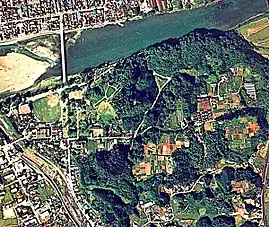| Hitoyoshi Domain 人吉藩 | |
|---|---|
| Domain of Japan | |
| 1585–1871 | |
 Mon of the Sagara clan
| |
| Capital | Hitoyoshi Castle |
| • Type | Daimyō |
| Historical era | Edo period |
• Established | 1585 |
• Disestablished | 1871 |
| Today part of | Kumamoto Prefecture |


The Hitoyoshi Domain (人吉藩, Hitoyoshi-han) was a Japanese domain of the Edo period. It was associated with Higo Province in modern-day Kumamoto Prefecture.[1]
In the han system, Hitoyoshi was a political and economic abstraction based on periodic cadastral surveys and projected agricultural yields.[2] In other words, the domain was defined in terms of kokudaka, not land area.[3] This was different from the feudalism of the West.
History
The Sagara clan was established at Hitoyoshi in the 13th century; and they stayed in the same place until the Meiji Restoration. The Sagara clan, the lord of the domain, was appointed as a land steward of this area in 1193 at the beginning of the Kamakura period. After that, it grew into a Sengoku daimyo (Japanese territorial lord in the Sengoku period) and survived as a feudal lord even in the Edo period and welcomed the Meiji Restoration.
During the Kyushu conquest of Toyotomi Hideyoshi in 1587, Shinsui Nagatomo, an old retainer, complained to Hideyoshi about the hardships of the small feudal lord sandwiched between the Otomo clan and the Shimazu clan. Due to Nagatomo's efforts, the head of the family, Sagara Yorifusa(later the first lord of the domain, Nagamei), was relieved of the territory. In 1596, the conflict between Fukami Nagatomo’s nephew Raizo and his senior vassal Yori Inudo intensified, and Ishida Mitsunari intervened. As a result, Yorizo lost the case and ran under Kiyomasa Kato, who was his backing, and the Shinsui clan was killed by his brother Yori. As a result, Inudo Yori's older brother named Seihei Sagara, became a chief retainer and administrator, and played a central role in the Sagara family.
In the Battle of Sekigahara in 1600, he initially joined the Western Army because of his gratitude to Mitsunari, who was in the mediation of the case. However, Yori performed a turn to the Eastern Army with the small feudal lords of Hyuga Province, such as Akizuki Tanenaga and Takahashi Mototane. As a result, they were relieved of their former territory from Ieyasu Tokugawa and established their own domains.
The Hitoyoshi Domain was an administrative organization that left a remnant of the Middle Ages that was very similar to the Satsuma Domain. One of them is the outer castle system. There were 14 outer castles in the territory, each of which was inhabited by several vassals and ruled the territory and the people of the territory. There was no separation of soldiers and peasants, and half-farm and half-soldier unpaid goshi accounted for about one-third of the population. In addition, it is the same as the Satsuma clan that strictly adhered to the prohibition of the Jodo Shinshu Hongan-ji school along with the prohibition of Christians.
In the early days, the domain finance was enriched by the business called "Nagasaki Shopping". Nagasaki Shopping is that the clan buys foreign textiles such as Irodonsu, Mosen, and Birodo in Nagasaki and makes profits by selling them in Kyoto.
In addition, it focused on the development of Nitta, and in the Kanei era, 21,000 koku of Nitta was developed. In addition, the Kuma River, one of the three major rapids in Japan, was thought that it was impossible to go upstream by boat, but the merchant Hayashi Masamori completed the river renovation work in 1665, which secured a waterway to Yatsushiro at the estuary and made it easy to carry in and out products. Along with this, when the funaba was established in Yatsushiro with the permission of the Hosokawa family of the Kumamoto Domain, the logistics between Kuma and Yatsushiro began to be carried out in the Kuma River.
However, the finance gradually deteriorated due to the help of the shogunate, the renovation of the domain residence, the flood of the Kuma River and the occurrence of Unka. The real height of feudal retainers with 100 koku in the Horeki era has decreased to about one-third of 36 koku. In addition, feudal retainers with more than 150 koku were obliged to possess horses, so those with a stipend at the last minute were particularly poor. Nevertheless, after the middle of the Edo period, when the finance of the domain deteriorated, the lord of the domain was short-lived and frequently changed, so it was not possible to deal with the reform, and the conflict within the domain (described later) was blunting the reform.
In the late Edo period, he encouraged the cultivation of oshiitake mushrooms, shiitake mushrooms, tea, etc. and tried to secure financial resources, but it did not work because it was fueled by conflicts within the domain.
In 1862, at the end of the Edo period, the castle town of Hitoyoshi was hit by a big fire called "Torasuke fire", and the finances suffered a lot.
After becoming Hitoyoshi Prefecture due to the abolition of feudal domains and establishment of prefectures in 1871, it was incorporated into Kumamoto Prefecture through Yatsushiro Prefecture and Shirakawa Prefecture. In 1869, the Sagara family became a peerage, and in 1884, they became a viscount.
Holdings at the end of the Edo period
• Higo Province - 54 villages
•Hyuga Province - 4 villages
[4]
List of daimyo
# Name Tenure Courtesy title Court Rank kokudaka  Sagara clan, 1585 - 1871(Tozama daimyo)
Sagara clan, 1585 - 1871(Tozama daimyo)1 Sagara Yorifusa (相良頼房) 1585 - 1636 Daisuke Miyauchi(大輔 宮内) Junior 5th Rank, Lower Grade (従五位下) 22,000 koku 2 Sagara Yorihiro (相良頼広) 1636 - 1664 Ike no kami (池 の 髪) Junior 5th Rank, Lower Grade (従五位下) 22,000 koku 3 Sagara Yoritaka (相良頼隆) 1664 - 1703 Tōtōmi no kami (遠江守) Junior 5th Rank, Lower Grade (従五位下) 22,000 koku 4 Sagara Yoritomi (相良頼富) 1703 - 1712 Uneme Masa (采女正) Junior 5th Rank, Lower Grade (従五位下) 22,000 koku 5 Sagara Nagaoki (相良長興 ) 1712 - 1721 Tōtōmi no kami (遠江守) Junior 5th Rank, Lower Grade (従五位下) 22,000 koku 6 Sagara Nagaari (相良長有) 1721 - 1738 Tōtōmi no kami (遠江守) Junior 5th Rank, Lower Grade (従五位下) 22,000 koku 7 Sagara Yorimine (相良頼峰) 1738 - 1758 Shimamori (島守) Junior 5th Rank, Lower Grade (従五位下) 22,000 koku 8 Sagara Yorihisa (相良頼久) 1758 - 1759 Tōtōmi no kami (遠江守) Junior 5th Rank, Lower Grade (従五位下) 22,000 koku 9 Sagara Akinaga (相良明長) 1759 - 1762 None (なし) Junior 5th Rank, Lower Grade (従五位下) 22,000 koku 10 Sagara Yorisada (相良頼貞) 1762 - 1767 Tōtōmi no kami (遠江守) Junior 5th Rank, Lower Grade (従五位下) 22,000 koku 11 Sagara Tomimochi (相良富持) 1767 - 1769 Echizen no kami(遠江守) Junior 5th Rank, Lower Grade (越前守) 22,000 koku 12 Sagara Nagahiro (相良長弘) 1769 - 1802 Ike no kami(池 の 髪) Junior 5th Rank, Lower Grade (越前守) 22,000 koku 13 Sagara Yorinori (相良頼則) 1802 - 1818 Tsushima no kami(池 の 髪) Junior 5th Rank, Lower Grade (対馬守 ) 22,000 koku 14 Sagara Yoriyuki (相良頼之) 1818 - 1839 Omi no kami(近江神) Junior 5th Rank, Lower Grade (越前守) 22,000 koku 15 Sagara Nagatomi (相良永富) 1839 - 1855 Iki no kami(壱岐神) Junior 5th Rank, Lower Grade (越前守) 22,000 koku 16 Sagara Yorimoto (相良頼基) 1855 - 1871 Echizen no kami(遠江守) Junior 5th Rank, Lower Grade (越前守) 22,000 koku
See also
References
- ↑ "Higo Province" at JapaneseCastleExplorer.com; retrieved 2013-5-28.
- ↑ Mass, Jeffrey P. and William B. Hauser. (1987). The Bakufu in Japanese History, p. 150.
- ↑ Elison, George and Bardwell L. Smith (1987). Warlords, Artists, & Commoners: Japan in the Sixteenth Century, p. 18.
- ↑ Papinot, Jacques Edmond Joseph. (1906). Dictionnaire d’histoire et de géographie du Japon; Papinot, (2003). "Hosokawa" at Nobiliare du Japon, p. 50; retrieved 2013-5-28.